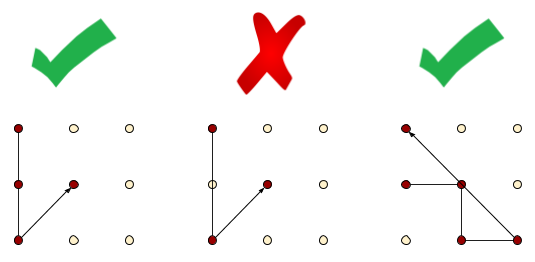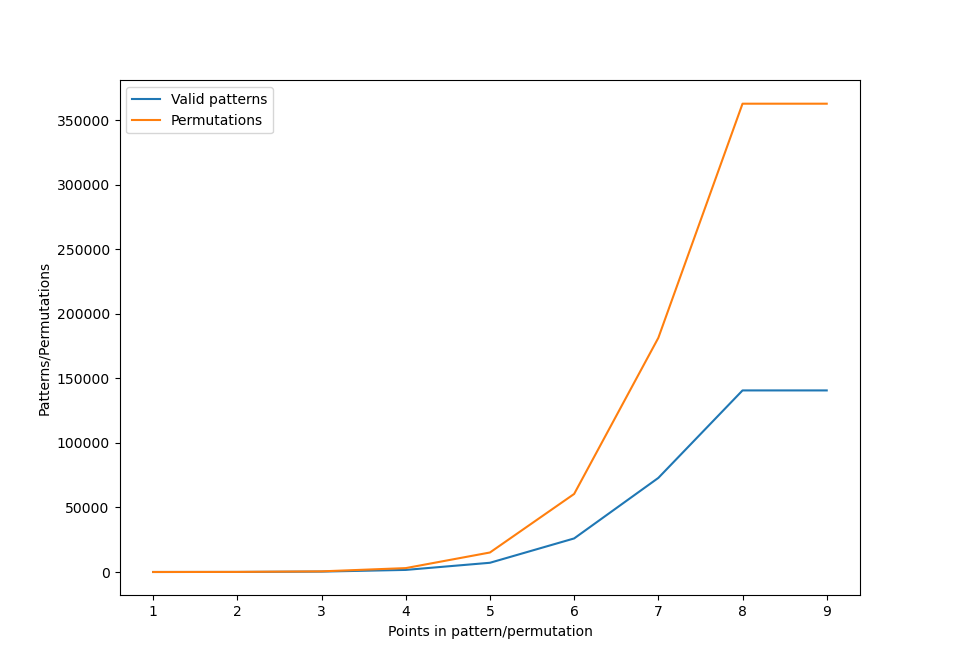If you own an Android smartphone, you are familiar with that pattern you chose to lock your phone with. Every time, you pick your phone and mechanically draw these lines on your screen, connecting the dots to form the unlock pattern.
Android lockscreen.
This lock mechanism is more intuitive than using a sequence of numbers (such as PIN), but has its drawbacks, as research papers show how you can efficiently guess the unlock pattern from
- the fact that people generally use an unlocking pattern starting with the top-left corner. This kind of assumption drastically reduces the search space for the attacker
- the path drawn by the oily residues of your fingers because it is the pattern you draw most often
These two attacks to the lock mechanism are commonly referred to as heuristic attack and smudge attack1 2 3.
Now the question is how many unlocking patterns are there, really? The answer is 389,112.
This number came from this research paper3. Let's verify this!
Rules for a valid pattern
As explained in this article4, there are three simple rules for a valid pattern
- The pattern must connect at least four points
- A point should be used once at most in the pattern
- An intermediate point becomes a contact point, unless it has already been connected before
Rules 1. and 2. imply that there should be at least one direction change in the pattern, so you cannot have obvious patterns like a straight line. However rule 3. is the most interesting because… sorry what? Oh, don't worry! It is a simple rule too, here is a graphical explanation.
Examples of valid and invalid patterns. You cannot cross without connecting a prececedently unconnected point.
The rule tells you have to always include points you cross on your path, unless they have already been included before. This is what I mean by "intermediate" point. Now, the interesting part of this rule is in how complex it makes the mathematical derivation of the number of possible patterns.
Mathematical resolution attempt
Let's ignore Rule 3. at first. With this simplification, a pattern connecting k points is equivalently a permutation of those k points taken from all the nine available points. A permutation is obtained by choosing in order k points from a bag containing 9 points. The number of different permutations is \[ P_k^n = 9\times 8 \times \dots \times (9 - k) = \frac{9!}{(9-k)!} \] We can then derive the total number of patterns by summing all patterns with 4 or more points (Rule 1.). \[ N_{\text{without Rule 3.}} = \sum_{k=4}^{9} \frac{9!}{(9-k)!} = 985824 \]
Now let's consider Rule 3., and think about what it changes. We now have to consider invalid permutations which should be subtracted from the total. This is manageable for patterns with 1,2 or 3 points, but it gets a lot harder for longer patterns. This complexity can be overcome by using a brute force algorithm which will test all patterns and count valid ones. Let's use Python code.
Programmatical resolution
In our code, we label each point using a digit.
Labelled points
INTERMEDIATE_POINT = {
"13": "2",
"46": "5",
"79": "8",
"17": "4",
"28": "5",
"39": "6",
"19": "5",
"37": "5"
}How do we know a given pattern is valid? Let's code a function that does that.
def is_pattern_valid(pattern):
"""We suppose the pattern is composed of unique characters. Returns True if no intermediate point is passed over, False otherwise."""
for sequence, point in INTERMEDIATE_POINT.items():
if sequence in pattern or sequence[::-1] in pattern:
if point not in pattern or pattern.index(point) > pattern.index(sequence[0]):
return False
return TrueWe have all we need to code the main algorithm. I consider using a recursive function to be the most natural choice. There are two stopping conditions to recursion:
- If the pattern is invalid
- If the pattern has maximum length, that is, it contains all points (because of Rule 2.)
We keep track of a variable count to count the number of valid patterns we found, and the recursive call is made on the pattern augmented with one point from the available points.
def count_patterns(pattern="", points="123456789", max_length=9, min_length=4):
# First, check Rule 3.
if is_pattern_valid(pattern):
count = 0
if len(pattern) >= min_length:
# Application of Rule 1.
count += 1
if len(pattern) == max_length or len(points) == 0:
# Stopping condition 2.
return count
else:
for p in points:
# Recursive call following Rule 2.
count += count_patterns(pattern + p, points.replace(p, ""),
max_length=max_length, min_length=min_length)
return count
else:
# Stopping condition 1.
return 0Let's run it.
count_patterns("", "123456789", max_length=9, min_length=4)This outputs 389,112. This confirms the result from the paper!
Appendix on the impact of Rule 3.
The following code is to demonstrate the impact of Rule 3. on the effective number of patterns. I print and plot the number of patterns by the number of connected points.
import math
import matplotlib.pyplot as plt
all_permutations = []
valid_patterns = []
n_points = range(1, 10)
for k in n_points:
all_permutations.append(math.perm(9, k))
valid_patterns.append(count_patterns(max_length=k, min_length=k))
plt.plot(n_points, valid_patterns, label="Valid patterns")
plt.plot(n_points, all_permutations, label="Permutations")
plt.ylabel('Patterns/Permutations')
plt.xlabel('Points in pattern/permutation')
plt.legend()
plt.show()
Number of patterns and permutations by the number of connected points
This last graph shows the number of patterns connecting the same given number of dots. So if you sum them all, you should obtain the number of total patterns that we computed. Remember to discard patterns with less than 3 dots and you get the number 389,112 for the blue line. We can also notice that the number of 8-dot patterns is the same as 9-dot patterns how is that so? Well, since there are only 9 dots available, when we have joined 8 dots together, there is only one remaining to form a 9-dot pattern, so in practical, 8-dot patterns are equivalent to 9-dot patterns.
Conclusion
And this concludes our short journey. That was some fun play with statistics! What do you think?
Footnotes
A pilot study on the security of pattern screen-lock methods and soft side channel attacks, https://dl.acm.org/doi/pdf/10.1145/2462096.2462098
A study on usability and security features of the Android pattern lock screen, https://www.emerald.com/insight/content/doi/10.1108/ICS-01-2015-0001/full/html
Smudge Attacks on Smartphone Touch Screens, https://www.usenix.org/legacy/event/woot10/tech/full_papers/Aviv.pdf
Smudge Attacks on Smartphone Touch Screens, Adam J. Aviv, Katherine Gibson, Evan Mossop, Matt Blaze, and Jonathan M. Smith.